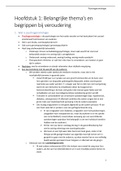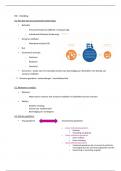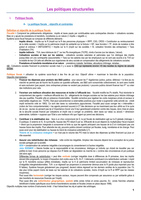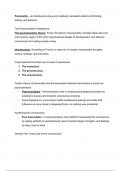Neuropsychology and pharmacology
Chapter 1: introducing cognitive neuroscience
Cognitive neuroscience
Cognitive neuroscience: aims to provide a brain-based account of cognitive and behavioural
processes
- Made possible by technological advances in studying the brain that are safer
Historical foundations
Do mental experiences arise in the heart ((Aristotle) or in the brain (Plato)?
- Mind-body problem: how can a physical substance give rise to mental experience?
Dualism: mind and body are separate substances
Dual-aspect theory: mind and body are two levels of explanation of the same thing
Reductionism: mind eventually explained solely in terms of physical/biological theory
Scientific approaches to mind and brain
- Early anatomists believed ventricles were important -> they believed this was the place where
mental experiences resided
- Cortex was often schematically drawn or misrepresented like intestines until 18 th century
- Gall and Spurzheim (1810) provide an accurate depiction of the features of the brain
Phrenology
- Different parts of cortex serve different functions
- Differences in personality traits manifest in differences in cortical size and bumps on skull
- Crude division of psychological traits and not grounded in science
- Although phrenology is discredited -> the notion that different regions of the brain serve
different functions -> has stood the test of time
- Modern cognitive neuroscience uses empirical methods to ascertain different functions
- It does not assume that each region has one function, or that each function has a discrete
location -> but does assume some degree of functional specialization
For example: Broca area (production) vs Wernicke area (comprehension) -> suggests at
least two language faculties in the brain that can be independently affected by brain
damage
Minds without brains: the computer metaphor
Much of twentieth-century psychology was concerned with observations of behaviour, rather than
observations of the brain during behaviour
- This led to models of cognition that do not make direct reference to the brain -> information-
processing models
- The models were inspired by thinking of the mind as a series of routines (like those found in
computers)
Connectionist models: are mathematical in nature but don’t involve serial processing and discrete
routines
The return of the brain: cognitive neuroscience
1970s: structural imaging methods (CT, MRI) -> enable precise images of the brain
1980s: PET adapted to models of cognition developed by psychologists
1985: TMS is first used
1990: level of oxygen in blood used as a measure of cognitive function -> principle behind fMRI
Methods of cognitive neuroscience
Recording -> bringing in chart
Invasive -> inject something in the brain
Hemodynamic -> using nutrients actively through the blood
Method Type Invasiveness Brain property used
EEG/ERP Recording Noninvasive Electrical
Single-cell Recording Invasive Electrical
TMS Stimulation Noninvasive Electromagnetic
, tES Stimulation Noninvasive Electric
MEG Recording Noninvasive Magnetic
PET Recording Invasive Hemodynamic
FMRI Recording Noninvasive Hemodynamic
fMIRS Recording Noninvasive Hemodynamic
Temporal resolution -> refers to the accuracy with which one can measure when an event is
occurring
Spatial resolution -> refers to the accuracy with which one can measure where an event is
occurring
Chapter 3: the electrophysiological brain
Mental representation = the way in which properties of the outside world are copied/stimulated by
cognition
Neural representation = the way in which properties of the outside world manifest themselves in the
neural signal
In search of neural representations: single-cell recordings
Single-cell recordings:
- Electrodes placed in (intercellular) or near a neuron (extracellular)
- Measure number of action potentials per second
- Action potentials of single neurons = basis of neural communication
Electro-encephalography (EEG)
- Electrodes placed on the skull
- Measures summed electrical potentials from millions of neurons
Distributed versus sparse coding
Rolls and Deco (2002) summarize three different kind of neural codes:
- Local representation -> grandmother cells: all the information about a stimulus/event is
carried in one of the neurons
- Fully distributed representation: all the information about a stimulus/event is carried in all
the neurons of a given population
- Sparse distributed representation: a distributed representation in which a small proportion
of the neurons carry information about a stimulus/event
Rate coding = the informational content of a neuron may be related to the number of action
potentials per second
Temporal coding = the synchrony of firing may be used by a population of neurons to code the same
stimulus or event
Electroencephalography and event-related potentials
Electroencephalography used in 2 main research contexts in cognitive neuroscience:
- Analyses of rates of oscillation and links to cognitive function
- Event-related potentials (ERPs)
Records electrical signals generated by the brain through electrodes placed on different points
on the scalp
Figure 3.7:
- These three neurons are all firing at a similar rate
- But two neurons also fire at the same time -> these two neurons can influence each others
excitability and hence be said to ‘communicate’
- If there are enough synchronous neurons that repeatedly fire -> then this wave-like structure
can be detected in the EEG signal at a particular frequency range determined by the distance in
time between the peaks of activity
Advantages and disadvantages of EEG:
- EEG signal is directly related to neural activity and this electrical activity is conducted
instantaneously to the scalp
EEG has an excellent temporal resolution
- The EEG signal is derived from different sources in the brain and it is not possible to infer
exactly where these sources are from the scalp -> inverse problem
EEG has a poor spatial resolution
Rhythmic fluctuations in the EEG signal
Oscillation-based analyses
- Also called -> frequency bands
, - Neurons tend to fire in synchrony with each other -> but at different frequencies
- Different fluctuation frequencies characterise the different phases of sleep-wake cycle
- Different frequencies also characterise certain cognitive functions
Increased alpha -> linked to visual attention
Increased gamma -> linked to perceptual grouping
Event-related potentials (ERPs)
- Based on EEG recordings
- EEG signal is averaged over many events and aligned to some aspect of the event
- Electrodes record a series of positive and negative peaks
- Timing and amplitude of the peaks is related to different aspects of the stimulus and task
Mental chronometry in electrophysiology and cognitive psychology
Mental chronometry = can be defined as the study of the time-course of information processing in
the human nervous system
- Classic method is response time to a task/stimuli and measure changes in RT across conditions
- Attempts to decompose this single measure
- ERP signal is continuous over time and has some advantages over RT method
Figure 3.11:
- Sternberg’s additive factors method assumes that if two variables affect different stages of
processing then they should have an additive effect on the overall reaction time -> but if two
variables affect the same stage of processing then the factors should have an interactive effect
- His task involved comparing a probe digit with an array of one, two or four digits held in mind
In ERP -> different peaks may approximately reflect the functioning of different cognitive stages
But not a simple relationship between ERP peak and cognition -> because each peak is a sum of
different electrical activities
Investigating face processing with ERPS and reaction times
Different ERP peaks associated with different aspects of face processing
Serial processing:
N170:
- Negative dale on 170msec after we displayed a face -> face selective
N250:
- Effect of familiarity -> if you recognize the face it is a different strength then if you don’t
recognize it
P400-P600:
- Also, for names etc.
Chapter 4: the imaged brain
Structural imaging
= measures of the spatial configuration of different types of tissue in the brain -> these different
properties can be used to construct detailed static maps of the physical structure of the brain
- Most common structural imaging methods:
Computerized tomography (CT) -> these scans are constructed according to the
amount of X-ray absorption in different types of tissue
Magnetic resonance imaging (MRI)
- Advantages of MRI over CT:
Does not use ionizing radiation
Better spatial resolution
Better discrimination between white matter and gray matter
Adapted for use in fMRI
MRI physics for non-physicists
MRI is used to create images of soft tissue of the body, which X-rays pas through largely undistorted
Linking structure to function
Voxel-based morphometry (VBM)
- A technique for segregating and measuring differences in white matter and gray matter
concentration
- Voxel -> a volume-based unit in imaging research the brain is divided into many thousands of
these
, - Can search for differences between groups of correlates with cognitive actions
Diffusion tensor imaging (DTI)
- Uses MRI to measure white matter connectivity between brain regions
- Based on limited diffusion of water molecules in axons -> fractional anisotropy
Functional imaging
= measures the moment-to-moment variable characteristics of the brain that may be associated with
changes in cognitive processing
- Neural activity consumes oxygen as well as generating electrical signals
- In order to compensate for increased oxygen consumption, more blood is pumped into the
active region
- The time taken for this response is slow and so functional imaging has a poor temporal
resolution, but a good spatial resolution
Positron Emission Tomography (PET)
- Measures local blood flow (rCBF)
- Radioactive tracer injected into blood stream
- Tracer takes up to 30 seconds to peak -> very slow temporal resolution
- Effective spatial resolution around 1 cm
- Advantage:
Good spatial resolution
- Disadvantage:
Low temporal resolution
Functional magnetic resonance imaging (fMRI)
- Does not use radioactivity, but signal is affected by the concentration of deoxyhemoglobin in the
blood -> this is called the BOLD response (Blood Oxygen Level Dependent contrast)
- The change in BOLD response over time is called -> hemodynamic response function (HRF)
and it has a number of distinct phases
- The Hemodynamic Response Function peaks in 6-8 seconds -> this limits the temporal
resolution of fMRI
- Has a high spatial resolution for a noninvasive method
- Advantage:
Doesn’t use a radioactive material + good spatial resolution
- Disadvantage:
Low temporal resolution
What does it mean to say a brain region is “active”?
- The brain has a constant supply of blood and oxygen -> if it didn’t, it would die
- This means we cannot literally stick someone in a scanner and read their thoughts
- In order to infer functional specialization -> one needs to compare relative differences in brain
activity between two or more conditions: cognitive subtraction
- This involves selecting a baseline or comparison condition
- A region is “active” if it shows a greater response in one condition relative to another
- if the experimenter chooses inappropriate conditions the regions of activity will be meaningless -
> functional imaging isn’t foolproof
In some regions there is even more activity during rest -> Default Mode Network
From image to cognitive theory: experimental design
Studie from Petersen et al. -> was designed to look for brain regions specialized for the processing of
written and spoken words -> this study provides a good introduction to the principle of cognitive
subtraction
- Idea behind cognitive subtraction is that, by comparing the activity of the brain in a task that
utilizes a particular cognitive component to the activity of the brain in a baseline task that does
not, it is possible to infer which region are specialized for this particular cognitive component to
the activity of the brain in a baseline task that does not, it is possible to infer which regions are
specialized for this particular cognitive component
- Basic cognitive stages involved in reading written words aloud and producing spoken semantic
associates to written words
- Cognitive subtraction is founded on the assumption that it is possible to find two tasks that differ
in terms of a small number of cognitive components -> the results show several regions of
activity, but only the main results on the left lateral surface are depicted here
Cognitive conjunctions and factorial designs
Why can’t we tickle ourselves?
Chapter 1: introducing cognitive neuroscience
Cognitive neuroscience
Cognitive neuroscience: aims to provide a brain-based account of cognitive and behavioural
processes
- Made possible by technological advances in studying the brain that are safer
Historical foundations
Do mental experiences arise in the heart ((Aristotle) or in the brain (Plato)?
- Mind-body problem: how can a physical substance give rise to mental experience?
Dualism: mind and body are separate substances
Dual-aspect theory: mind and body are two levels of explanation of the same thing
Reductionism: mind eventually explained solely in terms of physical/biological theory
Scientific approaches to mind and brain
- Early anatomists believed ventricles were important -> they believed this was the place where
mental experiences resided
- Cortex was often schematically drawn or misrepresented like intestines until 18 th century
- Gall and Spurzheim (1810) provide an accurate depiction of the features of the brain
Phrenology
- Different parts of cortex serve different functions
- Differences in personality traits manifest in differences in cortical size and bumps on skull
- Crude division of psychological traits and not grounded in science
- Although phrenology is discredited -> the notion that different regions of the brain serve
different functions -> has stood the test of time
- Modern cognitive neuroscience uses empirical methods to ascertain different functions
- It does not assume that each region has one function, or that each function has a discrete
location -> but does assume some degree of functional specialization
For example: Broca area (production) vs Wernicke area (comprehension) -> suggests at
least two language faculties in the brain that can be independently affected by brain
damage
Minds without brains: the computer metaphor
Much of twentieth-century psychology was concerned with observations of behaviour, rather than
observations of the brain during behaviour
- This led to models of cognition that do not make direct reference to the brain -> information-
processing models
- The models were inspired by thinking of the mind as a series of routines (like those found in
computers)
Connectionist models: are mathematical in nature but don’t involve serial processing and discrete
routines
The return of the brain: cognitive neuroscience
1970s: structural imaging methods (CT, MRI) -> enable precise images of the brain
1980s: PET adapted to models of cognition developed by psychologists
1985: TMS is first used
1990: level of oxygen in blood used as a measure of cognitive function -> principle behind fMRI
Methods of cognitive neuroscience
Recording -> bringing in chart
Invasive -> inject something in the brain
Hemodynamic -> using nutrients actively through the blood
Method Type Invasiveness Brain property used
EEG/ERP Recording Noninvasive Electrical
Single-cell Recording Invasive Electrical
TMS Stimulation Noninvasive Electromagnetic
, tES Stimulation Noninvasive Electric
MEG Recording Noninvasive Magnetic
PET Recording Invasive Hemodynamic
FMRI Recording Noninvasive Hemodynamic
fMIRS Recording Noninvasive Hemodynamic
Temporal resolution -> refers to the accuracy with which one can measure when an event is
occurring
Spatial resolution -> refers to the accuracy with which one can measure where an event is
occurring
Chapter 3: the electrophysiological brain
Mental representation = the way in which properties of the outside world are copied/stimulated by
cognition
Neural representation = the way in which properties of the outside world manifest themselves in the
neural signal
In search of neural representations: single-cell recordings
Single-cell recordings:
- Electrodes placed in (intercellular) or near a neuron (extracellular)
- Measure number of action potentials per second
- Action potentials of single neurons = basis of neural communication
Electro-encephalography (EEG)
- Electrodes placed on the skull
- Measures summed electrical potentials from millions of neurons
Distributed versus sparse coding
Rolls and Deco (2002) summarize three different kind of neural codes:
- Local representation -> grandmother cells: all the information about a stimulus/event is
carried in one of the neurons
- Fully distributed representation: all the information about a stimulus/event is carried in all
the neurons of a given population
- Sparse distributed representation: a distributed representation in which a small proportion
of the neurons carry information about a stimulus/event
Rate coding = the informational content of a neuron may be related to the number of action
potentials per second
Temporal coding = the synchrony of firing may be used by a population of neurons to code the same
stimulus or event
Electroencephalography and event-related potentials
Electroencephalography used in 2 main research contexts in cognitive neuroscience:
- Analyses of rates of oscillation and links to cognitive function
- Event-related potentials (ERPs)
Records electrical signals generated by the brain through electrodes placed on different points
on the scalp
Figure 3.7:
- These three neurons are all firing at a similar rate
- But two neurons also fire at the same time -> these two neurons can influence each others
excitability and hence be said to ‘communicate’
- If there are enough synchronous neurons that repeatedly fire -> then this wave-like structure
can be detected in the EEG signal at a particular frequency range determined by the distance in
time between the peaks of activity
Advantages and disadvantages of EEG:
- EEG signal is directly related to neural activity and this electrical activity is conducted
instantaneously to the scalp
EEG has an excellent temporal resolution
- The EEG signal is derived from different sources in the brain and it is not possible to infer
exactly where these sources are from the scalp -> inverse problem
EEG has a poor spatial resolution
Rhythmic fluctuations in the EEG signal
Oscillation-based analyses
- Also called -> frequency bands
, - Neurons tend to fire in synchrony with each other -> but at different frequencies
- Different fluctuation frequencies characterise the different phases of sleep-wake cycle
- Different frequencies also characterise certain cognitive functions
Increased alpha -> linked to visual attention
Increased gamma -> linked to perceptual grouping
Event-related potentials (ERPs)
- Based on EEG recordings
- EEG signal is averaged over many events and aligned to some aspect of the event
- Electrodes record a series of positive and negative peaks
- Timing and amplitude of the peaks is related to different aspects of the stimulus and task
Mental chronometry in electrophysiology and cognitive psychology
Mental chronometry = can be defined as the study of the time-course of information processing in
the human nervous system
- Classic method is response time to a task/stimuli and measure changes in RT across conditions
- Attempts to decompose this single measure
- ERP signal is continuous over time and has some advantages over RT method
Figure 3.11:
- Sternberg’s additive factors method assumes that if two variables affect different stages of
processing then they should have an additive effect on the overall reaction time -> but if two
variables affect the same stage of processing then the factors should have an interactive effect
- His task involved comparing a probe digit with an array of one, two or four digits held in mind
In ERP -> different peaks may approximately reflect the functioning of different cognitive stages
But not a simple relationship between ERP peak and cognition -> because each peak is a sum of
different electrical activities
Investigating face processing with ERPS and reaction times
Different ERP peaks associated with different aspects of face processing
Serial processing:
N170:
- Negative dale on 170msec after we displayed a face -> face selective
N250:
- Effect of familiarity -> if you recognize the face it is a different strength then if you don’t
recognize it
P400-P600:
- Also, for names etc.
Chapter 4: the imaged brain
Structural imaging
= measures of the spatial configuration of different types of tissue in the brain -> these different
properties can be used to construct detailed static maps of the physical structure of the brain
- Most common structural imaging methods:
Computerized tomography (CT) -> these scans are constructed according to the
amount of X-ray absorption in different types of tissue
Magnetic resonance imaging (MRI)
- Advantages of MRI over CT:
Does not use ionizing radiation
Better spatial resolution
Better discrimination between white matter and gray matter
Adapted for use in fMRI
MRI physics for non-physicists
MRI is used to create images of soft tissue of the body, which X-rays pas through largely undistorted
Linking structure to function
Voxel-based morphometry (VBM)
- A technique for segregating and measuring differences in white matter and gray matter
concentration
- Voxel -> a volume-based unit in imaging research the brain is divided into many thousands of
these
, - Can search for differences between groups of correlates with cognitive actions
Diffusion tensor imaging (DTI)
- Uses MRI to measure white matter connectivity between brain regions
- Based on limited diffusion of water molecules in axons -> fractional anisotropy
Functional imaging
= measures the moment-to-moment variable characteristics of the brain that may be associated with
changes in cognitive processing
- Neural activity consumes oxygen as well as generating electrical signals
- In order to compensate for increased oxygen consumption, more blood is pumped into the
active region
- The time taken for this response is slow and so functional imaging has a poor temporal
resolution, but a good spatial resolution
Positron Emission Tomography (PET)
- Measures local blood flow (rCBF)
- Radioactive tracer injected into blood stream
- Tracer takes up to 30 seconds to peak -> very slow temporal resolution
- Effective spatial resolution around 1 cm
- Advantage:
Good spatial resolution
- Disadvantage:
Low temporal resolution
Functional magnetic resonance imaging (fMRI)
- Does not use radioactivity, but signal is affected by the concentration of deoxyhemoglobin in the
blood -> this is called the BOLD response (Blood Oxygen Level Dependent contrast)
- The change in BOLD response over time is called -> hemodynamic response function (HRF)
and it has a number of distinct phases
- The Hemodynamic Response Function peaks in 6-8 seconds -> this limits the temporal
resolution of fMRI
- Has a high spatial resolution for a noninvasive method
- Advantage:
Doesn’t use a radioactive material + good spatial resolution
- Disadvantage:
Low temporal resolution
What does it mean to say a brain region is “active”?
- The brain has a constant supply of blood and oxygen -> if it didn’t, it would die
- This means we cannot literally stick someone in a scanner and read their thoughts
- In order to infer functional specialization -> one needs to compare relative differences in brain
activity between two or more conditions: cognitive subtraction
- This involves selecting a baseline or comparison condition
- A region is “active” if it shows a greater response in one condition relative to another
- if the experimenter chooses inappropriate conditions the regions of activity will be meaningless -
> functional imaging isn’t foolproof
In some regions there is even more activity during rest -> Default Mode Network
From image to cognitive theory: experimental design
Studie from Petersen et al. -> was designed to look for brain regions specialized for the processing of
written and spoken words -> this study provides a good introduction to the principle of cognitive
subtraction
- Idea behind cognitive subtraction is that, by comparing the activity of the brain in a task that
utilizes a particular cognitive component to the activity of the brain in a baseline task that does
not, it is possible to infer which region are specialized for this particular cognitive component to
the activity of the brain in a baseline task that does not, it is possible to infer which regions are
specialized for this particular cognitive component
- Basic cognitive stages involved in reading written words aloud and producing spoken semantic
associates to written words
- Cognitive subtraction is founded on the assumption that it is possible to find two tasks that differ
in terms of a small number of cognitive components -> the results show several regions of
activity, but only the main results on the left lateral surface are depicted here
Cognitive conjunctions and factorial designs
Why can’t we tickle ourselves?











